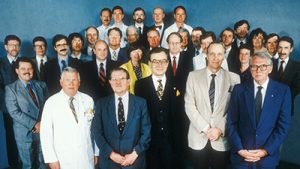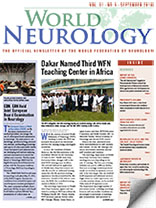
Front row, left to right: Charles G. Drake, John N. Walton, Vladimir Hachinski, John P. Girvin, and Henry J.M. Barnett, with members of the department of clinical neurological sciences at the University of Western Ontario in London, Canada.
My first knowledge of John N. Walton, MD, came from his reprint requests. My first papers were published as a resident (trainee in neurology). I was flattered that whatever I published was followed by a request from Professor Walton for a reprint. The requests were typed on half-page airmail envelopes and stated how much he appreciated the paper and asking for a reprint. He signed the requests individually, and I always obliged, although sometimes I would send him photocopies, since I could not afford reprints.
My next interaction related to a letter I wrote with other young stroke neurologists suggesting that the Cerebrovascular Research Group of the World Federation of Neurology (WFN) should allow for some renewal and not simply be run by the same people on the same themes with the same approaches. An appreciative and polite acknowledging letter came promptly, but action came much more slowly, due to the resistance of the Cerebrovascular Research Group leadership. In fact, it was not until my own presidency from 2009 to 2013 that we finally dissolved the lingering group in favor of the World Stroke Organization being the vascular arm of the World Brain Alliance, which we founded.
After years of honoring his reprint requests, I finally met Dr. Walton and his wonderful wife, Betty, in Uruguay. A personal relationship bloomed quickly to the point that he asked me for advice. He sought my opinion about what else needed to be done in world neurology. I produced a long list. Then he asked whether we were on the right track under his presidency. I responded “absolutely” without prior thought or hesitation. He then said he had a problem. He said he thought he needed another four years as president to push forward the WFN agenda, but Betty did not wish for him to have a second term. He said if I did not mind telling her what I told him, she could change her mind. I do not know whether anything that I said had any influence on Betty; the fact is Dr. Walton was renewed as president for another four milestone years.
I looked forward to meeting the Waltons at congresses, which they attended with admirable dedication and grace. At one of the congresses, Dr. Walton said, “You gave me advice when I needed it. If I may, I would like to give you some advice, although you may not need it.” I was eager to hear the advice, but was flabbergasted when he outlined the steps that I would have to take to become president of the WFN. I am not sure if I thanked him enough at the time, because the idea of becoming president of the WFN had never crossed my mind, but I had reason to be grateful for his words when I ran for office later in my career.
Twice, when I was chair of our department of clinical neurological sciences of the University of Western Ontario in London, Canada, I had the pleasure of inviting Dr. Walton as a visiting professor and co-hosting him along with his lifelong friend H.J.M. Barnett (Barney). Both were born in the same year (1922), in the same country (United Kingdom), and the same area: Dr. Barnett in Newcastle-Upon-Tyne, and Dr. Walton nearby. Both rose to the top, not only in their areas of expertise: Dr. Walton in neuromuscular and Dr. Barnett in stroke, but of neurology itself. Dr. Walton became president of the WFN and much else, and Dr. Barnett became president of the International Stroke Society and a number of other organizations. Their careers are reminiscent of Plutarch’s “Parallel Lives” wherein he compared a Greek and a Roman. I characterized Dr. Barnett as the “robust Roman” and Dr. Walton as the “sophisticated Greek.”1 Their careers were united in recognition at the 15th World Congress of Neurology in Vancouver, Canada (1993), when Dr. Barnett was the honorary president of the Congress and Dr. Walton was president of the WFN.
As the late Frank Clifford-Rose wrote about Dr. Walton in his biography in 1992, “that there were few doctors who were legends, and very few were legends in their lifetime,”2 however one seldom has the opportunity to learn about the personal dimensions of a legend.
I had such a privilege. At the 2009 World Congress of Neurology in Bangkok, the venue of the Congress and the hotels were far apart. I sat next to Dr. Walton in a van taking us from the venue through the nightmarish Bangkok traffic, providing ample time to talk. He remarked that when he started his career most boys with Duchenne’s dystrophy died in their teens, and now they were able to live far into their 30s with a good quality of life. He said this with such quiet compassion that I fell silent.
Nothing reveals more about a person’s character than how people face death. Dr. Walton knew that his glioblastoma was incurable. In response to the overwhelming outpouring of sympathy from those who knew him, he wrote an eloquent, gracious acknowledgement and stated that regretfully he would have to give up most of his commitments, but he would continue with fundraising for his charities and the presidency of the Bamburgh Castle Golf Club.
Even in his last days, his thoughts were about what he could for do for others. He lived the golden rule. Dr. Walton was not only a legend, but he was a good man.
References
1. Hachinski VC. H.J.M Barnett (A Biographical Sketch). Surg Neurol 1986;26:529-531
2. Aarli JA, Shakir R. In Memoriam. World Neurology Newsletter. July 2016. Vol 41; No. 4:3
